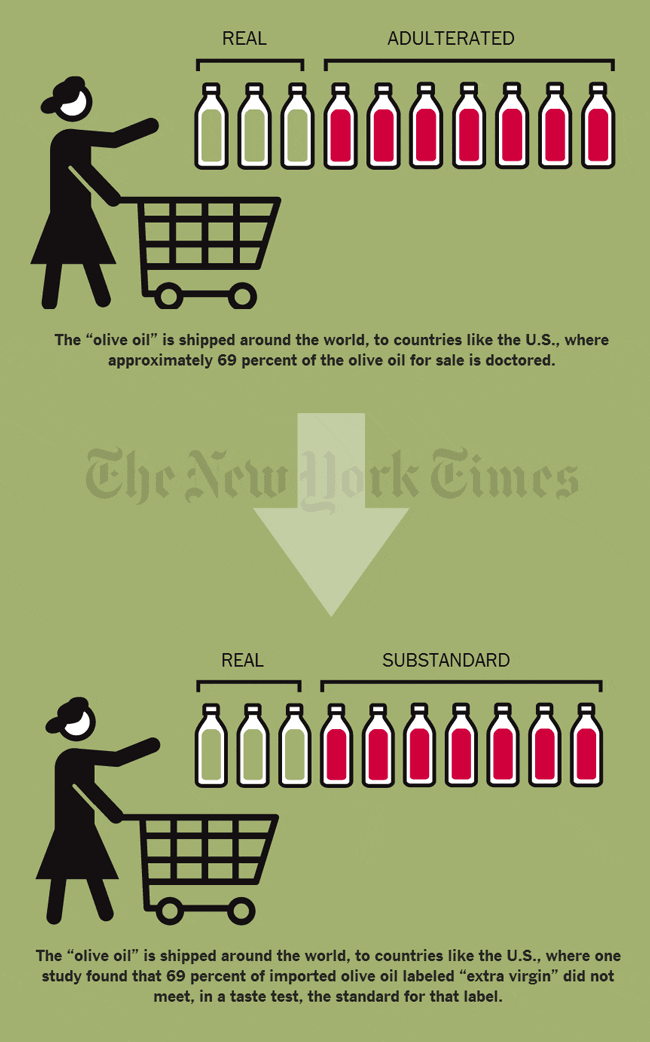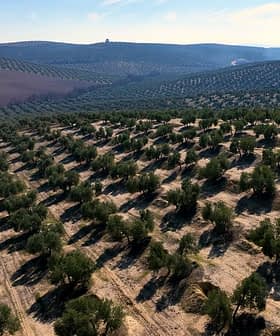The New York Times revised an infographic on olive oil fraud that critics said was sensational and inaccurate in parts.
The changes were made on the New York Times website today, just after 8:00 PM Eastern Standard Time, or about four days after the original piece was posted.
See Also:NY Times Olive Oil Fraud Infographic Timeline
Among the changes, Tom Mueller, author of the book Extra Virginity, was removed as the source of the article after Mueller insisted he was not responsible for the misinformation.
The slide that drew the most attention stated, “69 percent of the olive oil for sale (in the U.S.) is doctored.” The Times changed it to “69 percent of imported olive oil labeled ‘extra virgin’ did not meet, in a taste test, the standard for that label.”

Another slide originally read, “Bottles are labeled ‘Extra Virgin’ and branded with ‘Made in Italy’ (Oddly this is legal even if the oil does not come from Italy).”
It was changed to: “Bottles are labeled ‘Extra Virgin’ and labeled ‘Packed in Italy’ or ‘Imported from Italy.’ (Oddly, this is legal, even if the oil does not come from Italy — although the source countries are supposed to be listed on the label.)”
Another slide read, “The olive oil is cut with cheaper oil.” It was changed to: “At some refineries the olive oil is cut with cheaper oil.”
Earlier, the illustrator of the article complained in a Twitter update that he was “getting letters on the nuclear magnetic resonance of olive oil from Italian chemists,” yet he was “only an illustrator.” With Mueller removed as the article’s source, it remains unclear who wrote the piece.
An explanation of the corrections had not yet appeared on the Times Corrections page.
The corrections could relieve those who thought the article’s generalizations reinforced stereotypes and indicted legions of honest Italian olive oil producers. But when news travels at the speed of light, four days is an eternity, and the statements the Times retracted today had already been broadcast and shared around the world.

UPDATE (Feb. 25, 2014):
An earlier version of this graphic contained several errors.
Olives that are used in substandard oil are typically taken to mills days, weeks or even months after being picked — not “within hours.”
The graphic conflated two dubious practices that can be found in parts of the olive oil industry. Some producers mix olive oil with soybean or other cheap oils, while others mix vegetable oils with beta carotene and chlorophyll to produce fake olive oil; the two practices are not usually combined.
Olive oil bottled in Italy and sold in the United States may be labeled “packed in Italy” or “imported from Italy” — not “produced in Italy” — even if the oil does not come from Italy. (However, the source countries are supposed to be listed on the label.)
A 2010 study by researchers at the University of California, Davis, found that 69 percent of imported olive oil labeled “extra virgin” did not meet, in an expert taste and smell test, the standard for that label. The study suggested that the substandard samples had been oxidized; had been adulterated with cheaper refined olive oil; or were of poor quality because they were made from damaged or overripe olives, or olives that had been improperly stored or processed — or some combination of these flaws. It did not conclude that 69 percent of olive oil for sale in the United States was doctored.
Finally, the graphic incorrectly cited Tom Mueller, who runs the blog Truth in Olive Oil, as the source of the information. While Mr. Mueller’s blog and other writings were consulted in preparation of the graphic, several of his findings were misinterpreted.”
The New York Times Olive Oil Fraud Infographic Timeline


 Jan. 29, 2014 22:30 UTC
Jan. 29, 2014 22:30 UTC Olive Oil Times Staff
Olive Oil Times Staff






